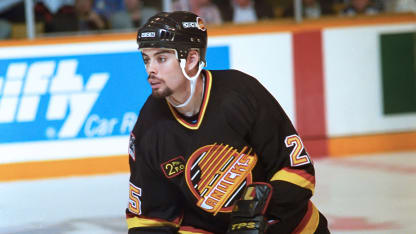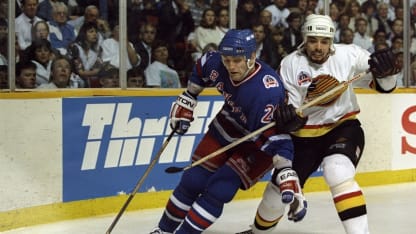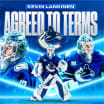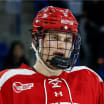Nathan LaFayette loves everything about Vancouver, the landscape, the people and the Canucks.
He’s has lived all over North America, and the B.C.-born former Canuck now resides with his family on the North Shore.
LaFayette was born in New Westminster, and his father David played for the B.C. Lions before the family moved to Toronto when LaFayette was a child. He’s found his way back twice, from 1993-95 as a forward for the Canucks and again in 2020 as the Chief Insurance Officer with BCAA.
“It’s just such a great town, it’s a great hockey town. It was certainly my favourite stop in my NHL career,” he said.
It was the people that made his experience special and what that Canucks team was able to achieve that made it memorable.
The first year of an NHL career he calls a ‘crash course’ learning how to be an NHLer and seeing the different coaching and leadership styles. LaFayette spent the first part of his rookie year in St. Louis and the captain at the time was former Vancouver Canuck Garth Butcher, who was a calming force for the Blues. In March of that season, he was traded to the Canucks under Pat Quinn’s tutelage and Trevor Linden’s captaincy, making the historic 1994 Stanely Cup Playoff run.
“The team itself was an amazing, cohesive, group of people. Very welcoming, just a great dressing room to be in. And then on top of that we got hot at the right time and went deep in the playoffs – it was great combination,” LaFayette shared.
“Trevor Linden had a very distinct style. He wasn’t a rah-rah cheerleader kind of guy, he was a guy that said ‘We need to work harder and let's go out and work harder’. We had an experienced defensive group that was rock solid. We had Pat Quinn [as head coach], Pat Quinn was amazing – his leadership style is something I call on to this day in my life in insurance. His ability to give you the straight goods, filter down big picture clutter into three things that mattered, communicate them and then hold people accountable for them. That was his superpower.”
LaFayette never found the same magic formula with the New York Rangers or Los Angeles Kings before calling it a career in 2000. Since hanging up the blades LaFayette has seen a lot of changes in the game of hockey both on and off the ice. While not all of these things have been perfect, for the most part, things have been positive especially when it comes to fans and those people who cheer for their team so passionately in the stands.
“I certainly feel like I see more diversity, I see diversity in the crowd, which I think is a big deal and a big change, a little harder to count, measure and report on, and I do think that as a fan when I go to a game, I find it encouraging that the game has broadened its exposure and I think that’s a wonderful thing,” he shared.
As a player, he didn't realize at the time that he was one of the first black people to play in the NHL. Willie O’Ree was a pioneer, making his debut in 1958, and in 35 years between O’Ree and LaFayette there were only six other black people that played in the NHL.
“I just figured there were other people like me that had gone through hockey before me and there were hundreds of them and there just wasn’t,” he said. “Looking back, something I’ve learned since I retired is that I was one of the first few people of colour to play in the NHL and that surprised me to learn that but I didn’t know it at the time.”




















